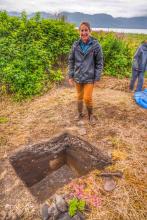Hollis Miller, a fifth year PhD student in archaeology was presented with the Alaska Anthropological Association's James W. VanStone Graduate Scholarship to support graduate training in the anthropology of the north at the association's annual meeting in late February 2020 in Fairbanks, Alaska. Hollis is developing an archaeological, archival, and community-oriented dissertation on Sugpiaq/Alutiiq responses to Russian colonialism in SE Kodiak, Alaska.
What brought you to anthropology?
My interest in anthropology originally stemmed from many trips throughout my childhood to museums such as the Smithsonian, the Philadelphia Academy of Natural Sciences, and the University of Pennsylvania Museum of Archaeology and Anthropology. It was in these spaces that I started to learn the stories of peoples from across the world, and I was totally captivated. I entered college knowing that I wanted to major in cultural anthropology, although I also picked up a geology major along the way. These two disciplines gave me the skills to explore questions over multiple timescales and to think historically in order to understand contemporary landscapes, societies and relationships. What won me over to an anthropology graduate program (and specifically archaeology), was a summer internship at the Smithsonian, where I was reminded of my early fascination with material culture, ancestral belongings, and the stories they tell.
How would you describe your field of study/research to a friend who is not in your graduate program?
I would tell them that I study colonialism using archaeology and oral history. I do this to understand how Indigenous peoples in North America experienced and negotiated and resisted colonialism in their daily lives. Specifically, I collaborate with Sugpiaq (Alutiiq) communities in the Kodiak Archipelago, Alaska, to uncover stories about life during the Russian occupation of Alaska (1784 to 1867).
What drew you to your topic?
After a failed attempt to join a project in the Andes, my advisor Ben Fitzhugh invited me on a trip to Kodiak to explore research possibilities with the community of Old Harbor. I had already begun to think seriously about Indigenous and collaborative archaeologies and how I might practice archaeology with, by, and for Native communities. During my initial visit, I discussed some possible research ideas with folks in Old Harbor and they were very supportive of research that explored the period of Sugpiaq history when Russians occupied Kodiak. Community leaders in Old Harbor were also adamant that any new archaeological research needed to include Sugpiaq youth. When I returned to Seattle, I started to do some reading on Russian colonialism in Alaska and noticed that it was vastly understudied in archaeology, especially from the perspective of Native Alaskans who had lived through and shaped this period. My dissertation research questions have grown from these experiences and conversations.
What’s been your experience so far?
I've been fortunate to have amazing support from my grad student cohort, my advisors and many community members in Old Harbor. With this support (and funding from the Department of Anthropology, the Quaternary Research Center and the Center for American Indian and Indigenous Studies), I have returned to Old Harbor twice more since that initial trip. During these trips, our field team, which included other graduate students from UW and youth interns from Old Harbor, conducted archaeological survey and test excavations at colonial period sites around Old Harbor. Last summer, we focused our work exclusively on Ing'yug, a historic Sugpiaq village that was occupied until the 1830s. Our initial excavation and mapping of Ing’yug documented multiple ciqlluat (Sugpiaq sod houses) and well-preserved middens. Uncovering these household contexts at Ing’yug is really exciting because they provide insight into the daily lives of Sugpiaq families through time. The house is both a living and working space, where labor, social relations, and foodways intersect. Excavating and analyzing a household context at Ing’yug will enable me to address my research questions about the lived experience of colonialism for Sugpiaq families.
While the archaeological components of the project provide one body of evidence about the past, the critical core of this project is collaboration with the Sugpiaq (Alutiiq) community of Old Harbor. This collaboration contextualizes archaeological data and interpretations within the living community, while also looking ahead towards a Sugpiaq future. This primarily involves engaging with Sugpiaq youth, but I also plan to work with Sugpiaq adults and elders to discuss and record oral histories about life in Old Harbor during and since Russian colonization.
What do you enjoy most about Seattle?
I love the close proximity of both ocean and mountains, and the summer weather here can't be beat!
What’s next?
Right now I am working on grant applications so that I can return to Kodiak this summer! Plans for the coming summer include archaeological excavation at Ing'yug and running a youth archaeology camp in collaboration with the Old Harbor Native Corporation.
What advice would you give to your past self about graduate school?
I would tell myself to take more risks in writing, research and thinking. It is in moments of discomfort that ideas transform, grow and strengthen!
